The Hemingray No. 9
by Charlie Angevine
Reprinted from "INSULATORS - Crown Jewels of the Wire", July 1975, page 7
When I began collecting several years ago, I had no idea how many sizes, shapes and colors of insulators there
were. This was before I had my first insulator book or knew that there was such a thing as a club of insulator
collectors. After joining the Pole Cats, buying some books and attending some shows, one thing became clear to
me -- I
would never be able to have every different insulator I saw.
In January 1974 I was talking with Dennis McHenry, NIA Treasurer, about my problem. Dennis is a long time
collector and has nearly the entire Hemingray line. Within
his collection he has a specialty group of Hemingray 9, CD
106. At that time he had 38 of them, all different, and suggested that they would make a fine inexpensive
specialty for me. The thought of so many different insulators by one manufacturer, as well as the usually low
price, appealed to me. In February 1974 I began my specialty with a single insulator. Now the collection has
grown to 72 pieces, all different in one way or another.
Mr. N. R. Woodward, in his book of insulator history,
states that the Hemingray 9 was introduced about 1900 and
continued in production virtually unchanged until 1955, when it was redesigned. I believe that run of 55 years is
the longest production run of any insulator. I also believe that the 1955 redesign was quite major; and in
later years when CD numbers were assigned, the old 9 was given CD 106, and the new 9 was given CD 107. I have no
proof of these assumptions.
Perhaps the long production run accounts for the variety found in the 9. Perhaps some of it can be attributed to
the mold wearing over the years. Or perhaps different mold makers used some artistic license to create a slightly
different looking insulator. Someday perhaps I'll be able to answer some of these things. One person who may be able
to supply some of the answers is Mr. Ern Parkison of Muncie, Indiana. Mr. Parkison, who worked for Hemingray
for 41 years, has already been very helpful. Someday I hope to meet him in person and gather more information on
this fascinating subject.
That's enough background information. Now I'll get on to
explaining what makes the insulators different. The things I use to judge by are as follows: embossing, color, dome
size, skirt length, drip points, manufacturing defects and embossing errors.
I have recorded 8 different embossing arrangements. This is without counting mold and lot numbers. If they were
counted, there would be no end to the arrangements. The list of arrangements would be more interesting if they
were in chronological order. As it is, they are in random order:
- HEMINGRAY 9 // MADE IN U.S.A.
- HEMINGRAY / No 9 // PATENT / MAY 2 1893 (The 2 in this one is a script 2, like the old written Q.)
- HEMINGRAY / No 9 // PATENTED / MAY 2 1893
- HEMINGRAY / No 9 // PATENT / MAY 2 1893
- HEMINGRAY / No 9 PATENTED
- HEMINGRAY - 9 / 0 // MADE IN U.S.A. (The 0 on the front is an alpha 0 and indicates the insulator was made by Owens-Illinois, who bought out
Hemingray in 1933.)
- HEMINGRAY // No 9
- HEMINGRAY / MADE IN U.S.A. // No 9
Still on the subject of embossing, it should be noted that there are many different sizes of characters used. Sometimes there is more than one size
on a single insulator. In most cases, the embossing is very strong, regardless of the size.
I know that colors are seen differently by each person, but I feel I have recorded 14 different colors:
|
1. Clear |
8. A Darker Blue (almost teal) |
|
2. Near Clear |
9. Lime Green |
|
3. Straw |
10. Seven Up Green |
|
4. Pale Aqua |
11. Green Aqua |
|
5. Aqua |
12. Emerald Green |
|
6. Ice Blue |
13. Jade Milk Glass |
|
7. Normal Hemingray Blue |
14. Amethyst (various shades) |
After the embossing and colors, the next most apparent thing in looking at a group of 9's, is the dome size. This is the diameter of the upper ridge of
the wire groove. I have recorded 11 different sizes, ranging from 2-3/32"
to
2-7/16".
The next most apparent difference is the skirt length. This is the distance from the end of the threads to the base. I have recorded 19 different
lengths, ranging from 1/4" to 1-1/2".
The next difference is not nearly so apparent as the others, mainly because the insulator sits on them. Of course I mean the drip points. I
finally gave up trying to record different drip shapes, and settled on just two: sharp and round. However, I have recorded 17 different numbers of
drip points, ranging from 26 to 42. I also understand some 9's were made without drips, but I have not seen any.
Manufacturing defects are usually easy to spot. I count in this category mixed colors and any other abnormalities. I have recorded nine of these
defects:
- Amber swirl in Aqua.
- Amber swirl in Ice Blue.
- Jade swirl in Aqua.
- Hemingray Blue full of tiny bubbles.
- Ghosting of letters on crown, as if insulator fell back into the mold.
- Varied size of drips on same insulator, as if too little glass was used.
- Black streaks in Pale Aqua.
- Skirt not the same length all around, as if it settled to one side during cooling.
- Jade and Amber swirl in Aqua.
The last difference is the embossing errors. These are usually easy to
spot, but sometimes they do take considerable looking. I have recorded six embossing errors:
- 'N' in Hemingray was overstruck with a 'G'.
- 'D' in Patented was omitted.
- 'M' in Hemingray was double struck.
- 'ED' in Patented was omitted.
- 'HEMINGRAY / No 9' embossed over an attempt to blot out PATENT / MAY 2 1893.
- 'M' in Hemingray was overstruck with an 'I'.
Sorry to have been so long winded, but I guess my 72 insulators have quite a story to tell. Thanks for inviting me to tell as much of the story
as I
know or can guess. Perhaps someday I'll be able to add to it.
In the meantime, I would be glad to hear from anyone who has any information relating to the Hemingray 9. I am also interested in buying or
trading for any 9's that are different.
Thank you, Charlie Angevine, for your Hemingray No. 9 article. It reminded me of an article on early Hemingrays we ran in our second issue, April
1969, which was the first issue we ran out of. So, for the benefit of new collectors and subscribers, I thought perhaps a reprint would be nice. As
you read the following article on old Hemingrays, keep in mind that it was written in 1969, so there could be some difference in the rarity scale; but
basically it's a good article to help you with your collecting of early Hemingrays.
We hope these two articles may inspire someone to write one on Hemingrays not covered here.
Your Editor
EARLY HEMINGRAYS
by Bob Anderson
(Copied from pages 3 - 11 of April 1969 issue of this journal.)
As with old Brookfields little is known of the early Hemingrays except that a patent was issued December 19, 1871 to Robert Hemingray covering a
method of forming insulators. This report deals with insulators so embossed and a few with the May 2, 1893 patent (covering drip points)
which were continuations of earlier styles.
BACKGROUND
Before concentrating on Hemingray it might be interesting to look briefly at
why so many companies tried their hand at making insulators. Glass houses in
those days were fire traps, and there probably wasn't a pleasant job in the
place. Even so, as with many other lines of work, if the money was good, the job
could be tolerated at least for a while.
Telegraph building during the second half of the 19th century was a booming
business. For instance, in an address at the Morse Testimonial June 10, 1871
William Orton, then president of Western Union, stated that in the U.S. alone
there were 180, 000 miles of telegraph wire and among Europe, India, and
Australia another 475, 000 miles. Further, the industry as a whole was expanding
at the rate of 100,000 miles of wire per year. Another account lists nearly
290,000 miles of wire in the U.S. early in 1878. This adds up to a growth rate
of 17,000 miles per year in the U.S. alone between mid-1871 and 1878.
These lines needed insulators. If one assumes that poles were placed every
150 feet or about 35 poles per mile, then 35 insulators were needed per mile of
wire. A Tillotson catalog from sometime in the 1880's lists insulator prices at
$35 to $50 per thousand. Assuming an average price of $40 per thousand, one mile
of wire insulation cost about $1.50. Using the 17,000 mile per year growth rate
this meant someone was being paid over $25,000 per year to furnish insulation in
the U.S. alone.
While it is true that workers had to be paid and raw materials to make glass
had to be purchased from this gross amount, still $1 was worth about three times
what it is now; and there were very few taxes. It is not hard then to see why
people wanted to make insulators especially if they already had an established
glass house as did Hemingray.
According to Woodward's The Glass Insulator in America 1967 Report,
Hemingray glass started in 1848, the Covington Kentucky plant was in operation
by 1858, and in 1874 the name became Hemingray Glass Company with Robert
Hemingray president. A plant was built in Muncie, Indiana and began operation
around 1890 though it is not known whether or not they made insulators. The
Covington plant operated until 1919 when it was destroyed by flood, and the
Muncie plant operated through 1933 when it was sold to Owens-Illinois.
The insulators themselves are for the most part 3 part mold. Early models are
what I call old 3 part mold; i. e. the mold seam goes around the insulator high
on the dome. The others are what is normally thought of as 3 part mold which
I'll call new 3 part mold. One cannot accurately date Hemingrays this way though
as there appears to be quite an overlapping period when both mold styles were
used.
There may have been some 2 part mold Hemingrays (the picture accompanying the
Dec. 19, 1871 patent shows a 2 part mold insulator of the Brookfield WUT style),
but as of this writing I don't know of any.
Hemingray embossing differs from Brookfield in that the numbers refer to the
styles, and letters designate lot numbers. A signal then with the 1871 patent on
one side and a 2 on the other is a Hemingray 2. One can be reasonably sure this
is correct because the number 4 Dec 19 1871 for instance was later embossed
Hemingray 4 (see numbers 4A and 4B on the list).
One other Hemingray feature is the flat collar at the base of the screw
threads which was included in the Hemingray patent. According to the patent the
insulator was formed by first pouring a quantity of glass into the mold. Next a
floating plunger was pressed into the mold pushing the molten glass around it
thus forming the insulator. When the glass reached the right height in the mold
the screw mandrel formed the threads through a hole in the bottom of the
plunger. This plunger, because it could be pushed to any given depth compensated
for too little or too much glass in the mold.
ABOUT THE LIST
The list contains only insulators I have seen and consists of the following:
- An identifying number which corresponds with a drawing (drawings appear at
the end of the list).
- Woodward's CD number if any.
- Embossing (a slash / means a new line, F means front, and B means back).
- Color
- Type of mold
- Rarity
- Additional comments
Rarity is a combination of scarcity and other appeal and is as follows :
Rarity 1 - Value over $20
Rarity 2 - $15 to $20
Rarity 3 - $10 to $15
Rarity 4 - less than $10
It should be remembered that these are one person's opinions only and by no
means an absolute price guide.
LIST
| 1. |
Hemingray 1 no CD number
F on dome PATENT/Dec 19 1871
B on dome 1
Color: aqua, green
Old 3 part mold
Rarity 1
This is the classic Hemingray. Not only is it old and scarce but it also
has an uncommon shape. I have seen an unembossed version of this
insulator which could also be Hemingray. |
 |
| 2. |
Hemingray 2 CD 132
F on dome PATENT/Dec 19 1871
B on dome 2
Color: green, light SCA
Old 3 part mold
Rarity 2 |
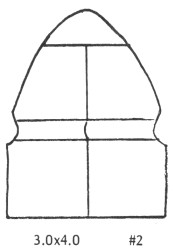 |
| 3A. |
Hemingray 3 CD 133
F on dome PATENT/Dec 19 1871
B on dome 3
Color: Green
Old 3 part mold
Rarity 2
This varies from #2 in that it is shorter, lighter (weight) and the dome
is more rounded. |
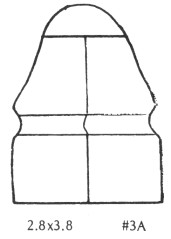 |
| 3B. |
Hemingray 3 similar to CD 133
F on skirt PATENT/Dec 19 1871
B on skirt 3
Color: green
New 3 part mold
Rarity 3
This appears to be a later version of #3A. |
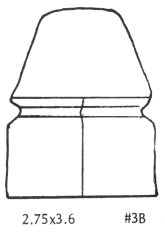 |
| 4A. |
Hemingray 4 similar to CD 124
F on dome PATENT/Dec 19 1871
B on dome 4
Color: aqua
Old 3 part mold
Rarity 2 |
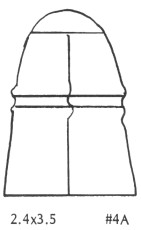 |
| 4B. |
Hemingray 4 CD 124
F on dome PAT Dec 19 1871
F on skirt 4/PATENT/May 2 1893
B on skirt HEMINGRAY/No 4 Color: aqua
Old 3 part mold
Rarity 2
This is an interesting one as it represents a transition from old to
new. The 1893 embossing is crooked, and it looks as though it and the
drip points were added after the original molding |
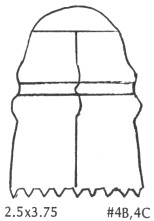 |
| 4C. |
Hemingray 4 CD 124
F on skirt PATENT/MAY 2 1893
B on skirt HEMINGRAY/No 4
Color: aqua
Old 3 part mold
Rarity 4
This one completes the transition from old to new. |
(see above) |
| 4D. |
Hemingray similar to CD 124
F on dome PATENT/DEC 19 1871
B on dome 4
Color: yellow green
Old 3 part mold
Rarity 2
This differs from #4A in that it has a longer skirt and different wire
groove. |
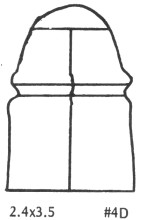 |
| 5A. |
Hemingray 5 CD 120
F on dome PAT DEC 19 1871
B on dome 5
Color: aqua
Old 3 part mold
Rarity 2 |
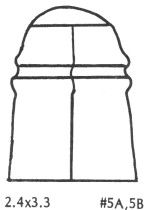 |
| 5B. |
Hemingray 5 CD 120
F on skirt PATENT/DEC 19 1871
B on skirt 5
Color: aqua
Old 3 part mold
Rarity 3
This is probably a later version of #5A. |
(see above) |
| 5C. |
Hemingray 5 CD 120
F on skirt PATENT/Dec 19 1871
B on skirt 5/PATENT May 2 1893
Color: aqua
Old 3 part mold
Rarity 2
This is another transition piece with both dates. |
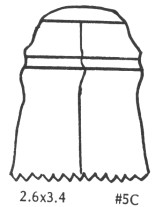 |
| 6A. |
WU5A CD 125
F on skirt PATENT/DEC 19 1871
B on skirt W U/5/A
Color: yellow green
New 3 part mold
Rarity 3
The A is probably a lot number. The W U in all likelihood stands for
Western Union. |
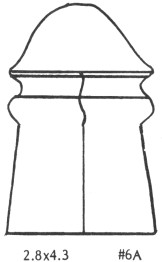 |
| 6B. |
WU5 or WU5B similar to CD 125
F on skirt PATENT/DEC 19 1871/B
B on skirt W. U./5
Color: aqua
New 3 part mold
Rarity 4
This looks like an improved version of the W.U. 5A. It has a larger wire
groove. |
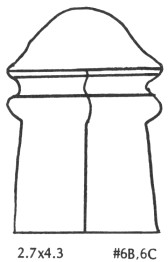 |
| 6c. |
WU No 5 similar to CD 125
F on skirt PATENT/May 2 1893
B on skirt HEMINGRAY/W.U. No 5
Color: aqua
New 3 part mold
Rarity 3
This is the same insulator as #6B except there are drip points on this
one (not shown in drawing). |
(see above) |
| 7. |
W E Mfg. no CD number
F on dome W. E. MFG. Co.
F on skirt PATENT/DEC 19 1871
B on dome W. U.
Color: various greens
Old 3 part mold
Rarity 2
Western Electric went by the name Western Electric Mfg. Co. at this time
so this could well be what the W. E. stands for. |
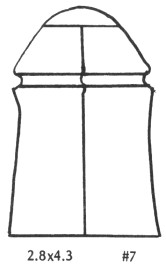 |
| 8. |
A. U. similar to CD IZ5
F on dome PATENT/DEC 19 1871
F on skirt A. U.
Color: aqua Old 3 part mold
Rarity 1
A. U. stands for American Union. I know no more about this unit except
that it is quite rare. |
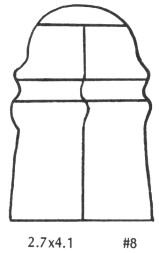 |
| 9. |
CD 134
F on skirt PATENT/DEC 19 1871
Color: light aqua
New 3 part mold
Rarity 4 |
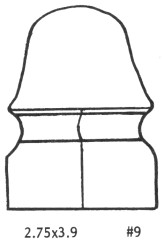 |
| 10. |
CD 134
F on skirt PATENT/DEC 19 1871
B on skirt PATENT MAY 2 1893
Color: aqua
New 3 part mold
Rarity 2
Here is another transition insulator. The 1893 patent is off center and
appears with the drip points to have been added later. |
 |
FINAL COMMENTS
This report has not attempted to answer all questions on early Hemingrays.
As a matter of fact it quite probably raises more than it answers such as :
- Are there Hemingray 6's and 7's? Tibbitts lists a Hemingray 8 with only
the 1893 patent.
- Were there WU 1's thru 5's?
- Are there 2 part mold Hemingrays ?
- What was the American Union (No. 8)?
I've attempted to tie together some of the known facts and also to propose
a few new ideas. If it's generated interest in early Hemingrays, it has been
well worth the effort.
| 